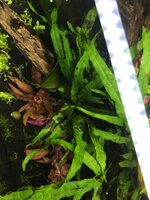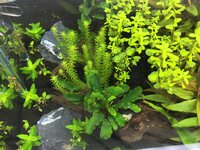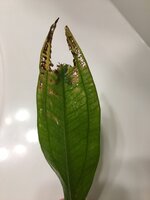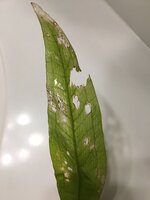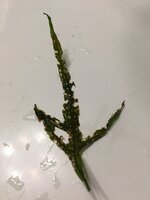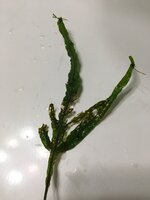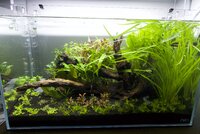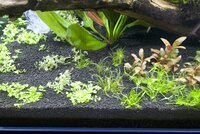Hi all.
I had over the last year several more or less unsuccessful trials with a 30L and 45L - 4 weeks ago I moved the usable plants to a new 60L and added also some new plants.
Some of the new plants (Alternanthera Reineckii 'mini', Echinodorus Tenellus, Micranthemum Monte Carlo - all tissue cultures) started melting after a week or so (see picture - this was an early stage, meanwhile not much of the plants is left ...) - most of these plants did not really survive, only some Echinodorus are still in the aqua and look ok.
I am dosing CO2 with an inline diffussor, approx 1-2BPS. I have 2 filters, which have a combined turnover of approx 800L/h, the outflows are in the back left corner and front right corner, shooting along the long glass sides. Both outflows are lily pipes, flow is ok - there is of course always room for improvement, esp in the lower levels ...?!?
I see however tiny bubbles flying almost everywhere around in the tank, but I would admit it might be less in the area of the affected melted plants (lower levels).
Since some days now I also detected holes and dark/black spots in the Microsorum Pteropus 'Trident' (see picture).
Additionally the Echinodorus Bleheri has a similar issue and 1(!) leaf (not necessarily the most recent one!), which looks rather pale. The Bleheri is one of the survivor plants from a older small tank - the plant looked in this tank already a bit troubled, but overall pretty usable/ok.
All other plants (stem plants, some Bucephalandra. Cyperus Helferi) look rather ok (see picture).
I am dosing ferts, adding the defined dosage of ADA green brighty neutral K, green brighty mineral and brighty iron every 2nd or 3rd (should be more often, but sometimes I simply forget or so ...).
Ammonia and Nitrite and 0, Nitrate is approx 15ppm.
KH is 0-1 (not sure if thats a measuring error or really that low..), GH 4.
pH is around 6.4, T=23degC.
I am assuming I have maybe a deficiency, or lack of CO2 distribution or maybe something else?
Hoping for your support!
Thanks a lot in advance
kolossi








I had over the last year several more or less unsuccessful trials with a 30L and 45L - 4 weeks ago I moved the usable plants to a new 60L and added also some new plants.
Some of the new plants (Alternanthera Reineckii 'mini', Echinodorus Tenellus, Micranthemum Monte Carlo - all tissue cultures) started melting after a week or so (see picture - this was an early stage, meanwhile not much of the plants is left ...) - most of these plants did not really survive, only some Echinodorus are still in the aqua and look ok.
I am dosing CO2 with an inline diffussor, approx 1-2BPS. I have 2 filters, which have a combined turnover of approx 800L/h, the outflows are in the back left corner and front right corner, shooting along the long glass sides. Both outflows are lily pipes, flow is ok - there is of course always room for improvement, esp in the lower levels ...?!?
I see however tiny bubbles flying almost everywhere around in the tank, but I would admit it might be less in the area of the affected melted plants (lower levels).
Since some days now I also detected holes and dark/black spots in the Microsorum Pteropus 'Trident' (see picture).
Additionally the Echinodorus Bleheri has a similar issue and 1(!) leaf (not necessarily the most recent one!), which looks rather pale. The Bleheri is one of the survivor plants from a older small tank - the plant looked in this tank already a bit troubled, but overall pretty usable/ok.
All other plants (stem plants, some Bucephalandra. Cyperus Helferi) look rather ok (see picture).
I am dosing ferts, adding the defined dosage of ADA green brighty neutral K, green brighty mineral and brighty iron every 2nd or 3rd (should be more often, but sometimes I simply forget or so ...).
Ammonia and Nitrite and 0, Nitrate is approx 15ppm.
KH is 0-1 (not sure if thats a measuring error or really that low..), GH 4.
pH is around 6.4, T=23degC.
I am assuming I have maybe a deficiency, or lack of CO2 distribution or maybe something else?
Hoping for your support!
Thanks a lot in advance
kolossi


